Comparative Analysis of Atmospheric Glyoxal Column Densities Retrieved from MAX-DOAS Observations in Pakistan and during MAD-CAT Field Campaign in Mainz, Germany
Abstract
:1. Introduction
2. Datasets and Methodology
2.1. MAD-CAT Field Campaign
2.2. Site Description
2.3. Mini MAX-DOAS Instrument
2.4. DOAS Analysis
3. Results and Discussions
3.1. MAD-CAT Campaign 2013
3.2. Atmospheric CHOCHO over the IESE-NUST Site in Pakistan
3.3. Diurnal Cycle in CHOCHO Emissions
4. Conclusions
Acknowledgments
Author Contributions
Conflicts of Interest
References
- Finlayson-Pitts, B.J.; Pitts, J.N., Jr. Chemistry of the Upper and Lower Atmosphere: Theory, Experiments, and Applications; Academic Press: San Diego, CA, USA, 1999. [Google Scholar]
- Volkamer, R.; Molina, L.T.; Molina, M.J.; Shirley, T.; Brune, W.H. DOAS measurement of glyoxal as an indicator for fast VOC chemistry in urban air. Geophys. Res. Lett. 2005, 32, L08806. [Google Scholar] [CrossRef]
- Seinfeld, J.H.; Pandis, S.N. Atmospheric Chemistry and Physics: From Air Pollution to Climate Change; John Wiley & Sons: New York, NY, USA, 2012. [Google Scholar]
- Gregg, J.W.; Jones, C.G.; Dawson, T.E. Urbanization effects on tree growth in the vicinity of New York city. Nature 2003, 424, 183–187. [Google Scholar] [CrossRef] [PubMed]
- Ramanathan, V.; Li, F.; Ramana, M.; Praveen, P.; Kim, D.; Corrigan, C.; Nguyen, H.; Stone, E.A.; Schauer, J.J.; Carmichael, G. Atmospheric brown clouds: Hemispherical and regional variations in long-range transport, absorption, and radiative forcing. J. Geophys. Res.: Atmos. 2007, 112, S21. [Google Scholar] [CrossRef]
- Molina, L.T.; Molina, M.J. Air Quality in the Mexico Megacity: An Integrated Assessment; SciELO Chile: Santiago, Chile, 2002. [Google Scholar]
- Pope, C.A., III; Dockery, D.W. Health effects of fine particulate air pollution: Lines that connect. J. Air Waste Manag. Assoc. 2006, 56, 709–742. [Google Scholar] [CrossRef] [PubMed]
- Myriokefalitakis, S.; Vrekoussis, M.; Tsigaridis, K.; Wittrock, F.; Richter, A.; Brühl, C.; Volkamer, R.; Burrows, J.; Kanakidou, M. The influence of natural and anthropogenic secondary sources on the glyoxal global distribution. Atmos. Chem. Phys. 2008, 8, 4965–4981. [Google Scholar] [CrossRef]
- Atkinson, R. Atmospheric chemistry of VOCS and NO X. Atmos. Environ. 2000, 34, 2063–2101. [Google Scholar] [CrossRef]
- MacDonald, S.; Oetjen, H.; Mahajan, A.; Whalley, L.; Edwards, P.; Heard, D.; Jones, C.; Plane, J. DOAS measurements of formaldehyde and glyoxal above a South-East Asian tropical rainforest. Atmos. Chem. Phys. 2012, 12, 5949–5962. [Google Scholar] [CrossRef]
- Fu, T.M.; Jacob, D.J.; Wittrock, F.; Burrows, J.P.; Vrekoussis, M.; Henze, D.K. Global budgets of atmospheric glyoxal and methylglyoxal, and implications for formation of secondary organic aerosols. J. Geophys. Res. Atmos. 2008, 113, D15303. [Google Scholar] [CrossRef]
- Guenther, A.; Hewitt, C.N.; Erickson, D.; Fall, R.; Geron, C.; Graedel, T.; Harley, P.; Klinger, L.; Lerdau, M.; McKay, W. A global model of natural volatile organic compound emissions. J. Geophys. Res. Atmos. 1995, 100, 8873–8892. [Google Scholar] [CrossRef]
- Alvarado, L.; Richter, A.; Vrekoussis, M.; Wittrock, F.; Hilboll, A.; Schreier, S.; Burrows, J. An improved glyoxal retrieval from OMI measurements. Atmos. Meas. Tech. 2014, 7, 4133–4150. [Google Scholar] [CrossRef]
- Tadić, J.; Moortgat, G.K.; Wirtz, K. Photolysis of glyoxal in air. J. Photochem. Photobiol. A Chem. 2006, 177, 116–124. [Google Scholar] [CrossRef]
- Setokuchi, O. Trajectory calculations of OH radical-and CL atom-initiated reaction of glyoxal: Atmospheric chemistry of the HC(O)CO radical. Phys. Chem. Chem. Phys. 2011, 13, 6296–6304. [Google Scholar] [CrossRef] [PubMed]
- Volkamer, R.; San Martini, F.; Molina, L.T.; Salcedo, D.; Jimenez, J.L.; Molina, M.J. A missing sink for gas-phase glyoxal in Mexico city: Formation of secondary organic aerosol. Geophys. Res. Lett. 2007, 34, L19807. [Google Scholar] [CrossRef]
- Sinreich, R.; Volkamer, R.; Filsinger, F.; Frieß, U.; Kern, C.; Platt, U.; Sebastián, O.; Wagner, T. MAX-DOAS detection of glyoxal during ICARTT 2004. Atmos. Chem. Phys. 2007, 7, 1293–1303. [Google Scholar] [CrossRef]
- Li, X.; Brauers, T.; Hofzumahaus, A.; Lu, K.; Li, Y.; Shao, M.; Wagner, T.; Wahner, A. MAX-DOAS measurements of NO2, HCHO and CHOCHO at a rural site in Southern china. Atmos. Chem. Phys. 2013, 13, 2133–2151. [Google Scholar] [CrossRef]
- Coburn, S.; Dix, B.; Sinreich, R.; Volkamer, R. The CU ground MAX-DOAS instrument: Characterization of RMS noise limitations and first measurements near Pensacola, FL of BRO, IO, and CHOCHO. Atmos. Meas. Tech. 2011, 4, 2421–2439. [Google Scholar] [CrossRef]
- Lerot, C.; Stavrakou, T.; Smedt, I.D.; Müller, J.-F.; Roozendael, M.V. Glyoxal vertical columns from Gome-2 backscattered light measurements and comparisons with a global model. Atmos. Chem. Phys. 2010, 10, 12059–12072. [Google Scholar] [CrossRef]
- Vlemmix, T.; Piters, A.; Stammes, P.; Wang, P.; Levelt, P. Retrieval of tropospheric NO2 using the MAX-DOAS method combined with relative intensity measurements for aerosol correction. Atmos. Meas. Tech. 2010, 3, 1287–1305. [Google Scholar] [CrossRef]
- Vrekoussis, M.; Wittrock, F.; Richter, A.; Burrows, J. Temporal and spatial variability of glyoxal as observed from space. Atmos. Chem. Phys. 2009, 9, 4485–4504. [Google Scholar] [CrossRef]
- Fayt, C.; Van Roozendael, M. Windoas 2.1–Software User Manual; BIRA-IASB: Uccle, belgium, 2001. [Google Scholar]
- Irie, H.; Takashima, H.; Kanaya, Y.; Boersma, K.; Gast, L.; Wittrock, F.; Brunner, D.; Zhou, Y.; Roozendael, M.V. Eight-component retrievals from ground-based MAX-DOAS observations. Atmos. Meas. Tech. 2011, 4, 1027–1044. [Google Scholar] [CrossRef]
- Theys, N.; Van Roozendael, M.; Hendrick, F.; Yang, X.; De Smedt, I.; Richter, A.; Begoin, M.; Errera, Q.; Johnston, P.; Kreher, K. Global observations of tropospheric bro columns using Gome-2 satellite data. Atmos. Chem. Phys. 2011, 11, 1791–1811. [Google Scholar] [CrossRef] [Green Version]
- Wagner, T.; Beirle, S.; Brauers, T.; Deutschmann, T.; Frieß, U.; Hak, C.; Halla, J.; Heue, K.; Junkermann, W.; Li, X. Inversion of tropospheric profiles of aerosol extinction and HCHO and NO2 mixing ratios from MAX-DOAS observations in Milano during the summer of 2003 and comparison with independent data sets. Atmos. Meas. Tech. 2011, 4, 2685–2715. [Google Scholar] [CrossRef]
- Wittrock, F.; Oetjen, H.; Richter, A.; Fietkau, S.; Medeke, T.; Rozanov, A.; Burrows, J. MAX-DOAS measurements of atmospheric trace gases in NY-Ålesund-Radiative transfer studies and their application. Atmos. Chem. Phys. 2004, 4, 955–966. [Google Scholar] [CrossRef]
- Akhtar, M.; Ahmad, N.; Booij, M. The impact of climate change on the water resources of Hindukush–Karakorum–Himalaya region under different glacier coverage scenarios. J. Hydrol. 2008, 355, 148–163. [Google Scholar] [CrossRef]
- Parry, M.L.; Rosenzweig, C.; Iglesias, A.; Livermore, M.; Fischer, G. Effects of climate change on global food production under SRES emissions and socio-economic scenarios. Glob. Environ. Chang. 2004, 14, 53–67. [Google Scholar] [CrossRef]
- Le Houérou, H.N. Climate change, drought and desertification. J. Arid Environ. 1996, 34, 133–185. [Google Scholar] [CrossRef]
- Rosenzweig, C.; Parry, M.L. Potential impact of climate change on world food supply. Nature 1994, 367, 133–138. [Google Scholar] [CrossRef]
- McMichael, A.J. Globalization, climate change, and human health. N. Engl. J. Med. 2013, 368, 1335–1343. [Google Scholar] [CrossRef] [PubMed]
- Death Toll Climbs as Weather Experts Link Pakistan Heat Wave to Climate Change. Available online: http://ecowatch.com/2015/07/06/pakistan-heatwave-climate-change/ (accessed on 13 May 2016).
- Cases of Cold-Induced Injuries on the Rise. Available online: http://www.thenews.com.pk/print/84843-Cases-of-cold-induced-injuries-on-the-rise# (accessed on 13 May 2016).
- Mad-CAT. Available online: http://joseba.mpch-mainz.mpg.de/equipment.htm (accessed on 13 May 2016).
- Heckel, A.; Richter, A.; Tarsu, T.; Wittrock, F.; Hak, C.; Pundt, I.; Junkermann, W.; Burrows, J. MAX-DOAS measurements of formaldehyde in the Po-valley. Atmos. Chem. Phys. 2005, 5, 909–918. [Google Scholar] [CrossRef]
- Pikelnaya, O.; Hurlock, S.C.; Trick, S.; Stutz, J. Intercomparison of Multiaxis and long-path differential optical absorption spectroscopy measurements in the marine boundary layer. J. Geophys. Res. Atmos. 2007, 112. [Google Scholar] [CrossRef]
- Vlemmix, T.; Piters, A.; Berkhout, A.; Gast, L.; Wang, P.; Levelt, P. Ability of the MAX-DOAS method to derive profile information for NO2: Can the boundary layer and free troposphere be separated? Atmos. Meas. Tech. 2011, 4, 2659–2684. [Google Scholar] [CrossRef]
- Platt, U.; Stutz, J. Differential Absorption Spectroscopy; Springer: Berlin/Heidelberg, Germany, 2008. [Google Scholar]
- Frieß, U.; Monks, P.; Remedios, J.; Rozanov, A.; Sinreich, R.; Wagner, T.; Platt, U. MAX-DOAS O4 measurements: A new technique to derive information on atmospheric aerosols: 2. Modeling studies. J. Geophys. Res. Atmos. 2006, 111. [Google Scholar] [CrossRef]
- Hönninger, G.; Friedeburg, C.V.; Platt, U. Multi axis differential optical absorption spectroscopy (MAX-DOAS). Atmos. Chem. Phys. 2004, 4, 231–254. [Google Scholar] [CrossRef]
- Leser, H.; Hönninger, G.; Platt, U. MAX-DOAS measurements of bro and NO2 in the marine boundary layer. Geophys. Res. Lett. 2003, 30. [Google Scholar] [CrossRef]
- Van Roozendael, M.; Fayt, C.; Post, P.; Hermans, C.; Lambert, J. Retrieval of bro and NO2 from UV-Visible Observations. Sounding the Troposphere from Space: A New Era for Atmospheric Chemistry; Springer-Verlag: Heidelberg, Germany, 2003. [Google Scholar]
- Vandaele, A.C.; Hermans, C.; Simon, P.C.; Carleer, M.; Colin, R.; Fally, S.; Merienne, M.-F.; Jenouvrier, A.; Coquart, B. Measurements of the NO2 absorption cross-section from 42,000 cm−1 to 10,000 cm−1 (238–1000 nm) at 220 K and 294 K. J. Quant. Spectrosc. Radiat. Trans. 1998, 59, 171–184. [Google Scholar] [CrossRef]
- Bogumil, K.; Orphal, J.; Homann, T.; Voigt, S.; Spietz, P.; Fleischmann, O.; Vogel, A.; Hartmann, M.; Kromminga, H.; Bovensmann, H. Measurements of molecular absorption spectra with the sciamachy pre-flight model: Instrument characterization and reference data for atmospheric remote-sensing in the 230–2380 nm region. J. Photochem. Photobiol. A Chem. 2003, 157, 167–184. [Google Scholar] [CrossRef]
- Thalman, R.; Volkamer, R. Temperature dependent absorption cross-sections of O 2–O 2 collision pairs between 340 and 630 nm and at atmospherically relevant pressure. Phys. Chem. Chem. Phys. 2013, 15, 15371–15381. [Google Scholar] [CrossRef] [PubMed]
- Volkamer, R.; Spietz, P.; Burrows, J.; Platt, U. High-resolution absorption cross-section of glyoxal in the UV–VIS and IR spectral ranges. J. Photochem. Photobiol. A Chem. 2005, 172, 35–46. [Google Scholar] [CrossRef]
- Rothman, L.S. The evolution and impact of the HITRAN molecular spectroscopic database. J. Quant. Spectrosc. Radiac. Transf. 2010, 111, 1565–1567. [Google Scholar] [CrossRef]
- Rothman, L.S.; Jacquemart, D.; Barbe, A.; Benner, D.C.; Birk, M.; Brown, L.; Carleer, M.; Chackerian, C.; Chance, K.; Coudert, L.; et al. The HITRAN 2004 molecular spectroscopic database. J. Quant. Spectrosc. Radiac. Transf. 2005, 96, 139–204. [Google Scholar] [CrossRef]
- Voigt, S.; Orphal, J.; Burrows, J. The temperature and pressure dependence of the absorption cross-sections of no 2 in the 250–800 nm region measured by fourier-transform spectroscopy. J. Photochem. Photobiol. A Chem. 2002, 149, 1–7. [Google Scholar] [CrossRef]
- Voigt, S.; Orphal, J.; Bogumil, K.; Burrows, J. The temperature dependence (203–293 K) of the absorption cross sections of o 3 in the 230–850 nm region measured by fourier-transform spectroscopy. J. Photochem. Photobiol. A Chem. 2001, 143, 1–9. [Google Scholar] [CrossRef]
- Greenblatt, G.D.; Orlando, J.J.; Burkholder, J.B.; Ravishankara, A. Absorption measurements of oxygen between 330 and 1140 nm. J. Geophys. Res. Atmos. 1990, 95, 18577–18582. [Google Scholar] [CrossRef]
- Hermans, C. Measurement of Absorption Cross Sections and Spectroscopic Molecular Parameters: O2 and its Collisional Induced Absorption. Available online: http://spectrolab.aeronomie.be/o2.htm (accessed on 29 February 2015).
- Hendrick, F.; Roozendael, M.V.; Kylling, A.; Petritoli, A.; Rozanov, A.; Sanghavi, S.; Schofield, R.; Friedebufrg, C.V.; Wagner, T.; Wittrock, F. Intercomparison exercise between different radiative transfer models used for the interpretation of ground-based zenith-sky and multi-AXIS DOAS observations. Atmos. Chem. Phys. 2006, 6, 93–108. [Google Scholar] [CrossRef]
- Wagner, T.; Burrows, J.; Deutschmann, T.; Dix, B.; Friedeburg, C.V.; Frieß, U.; Hendrick, F.; Heue, K.-P.; Irie, H.; Iwabuchi, H. Comparison of box-air-mass-factors and radiances for multiple-axis differential optical absorption spectroscopy (MAX-DOAS) geometries calculated from different UV/Visible radiative transfer models. Atmos. Chem. Phys. 2007, 7, 1809–1833. [Google Scholar] [CrossRef]
- Lamb, B.; Guenther, A.; Gay, D.; Westberg, H. A national inventory of biogenic hydrocarbon emissions. Atmos. Environ. 1987, 21, 1695–1705. [Google Scholar] [CrossRef]
- Guenther, A.; Geron, C.; Pierce, T.; Lamb, B.; Harley, P.; Fall, R. Natural emissions of non-methane volatile organic compounds, carbon monoxide, and oxides of nitrogen from north America. Atmos. Environ. 2000, 34, 2205–2230. [Google Scholar] [CrossRef]
- Liggio, J.; Li, S.-M.; McLaren, R. Heterogeneous reactions of glyoxal on particulate matter: Identification of acetals and sulfate esters. Environ. Sci. Technol. 2005, 39, 1532–1541. [Google Scholar] [CrossRef] [PubMed]
- Huisman, A.; Hottle, J.; Galloway, M.; DiGangi, J.; Coens, K.; Choi, W.; Faloona, I.; Gilman, J.; Kuster, W.; Gouw, J.D. Photochemical modeling of glyoxal at a rural site: Observations and analysis from Bearpex 2007. Atmos. Chem. Phys. 2011, 11, 8883–8897. [Google Scholar] [CrossRef]
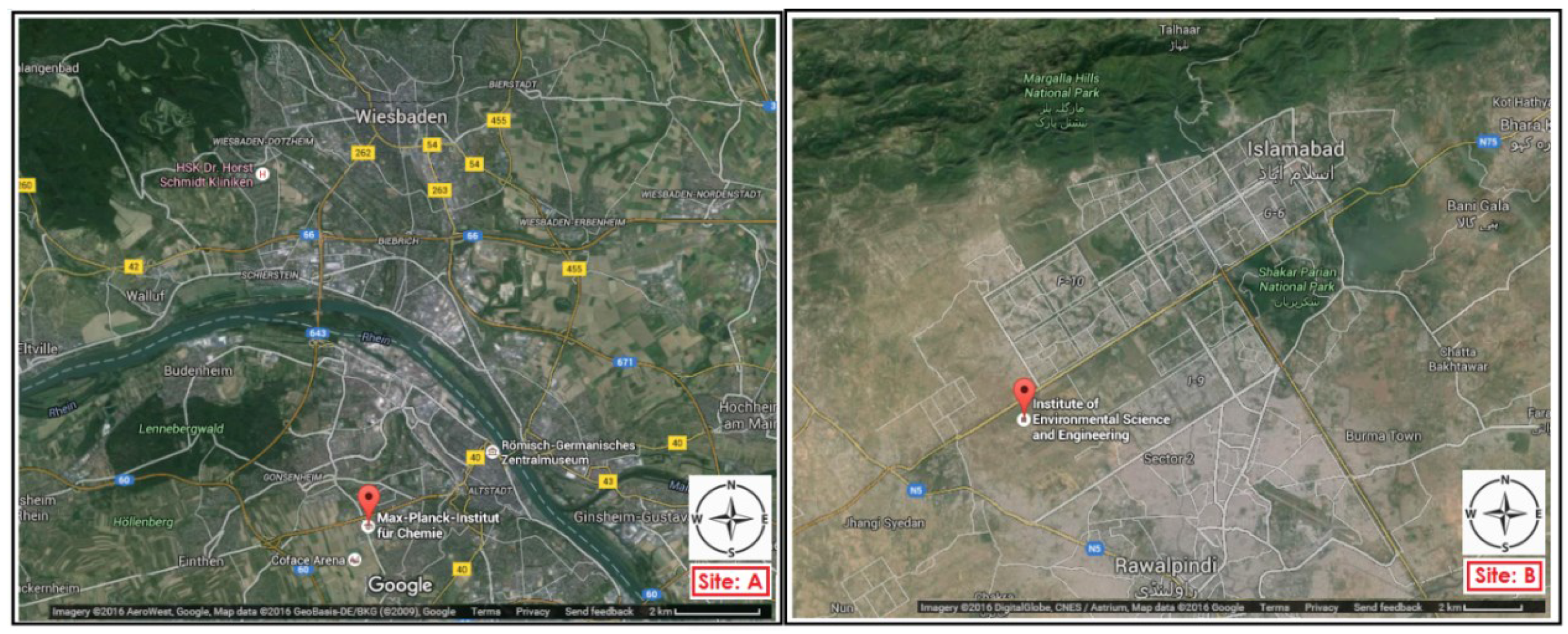
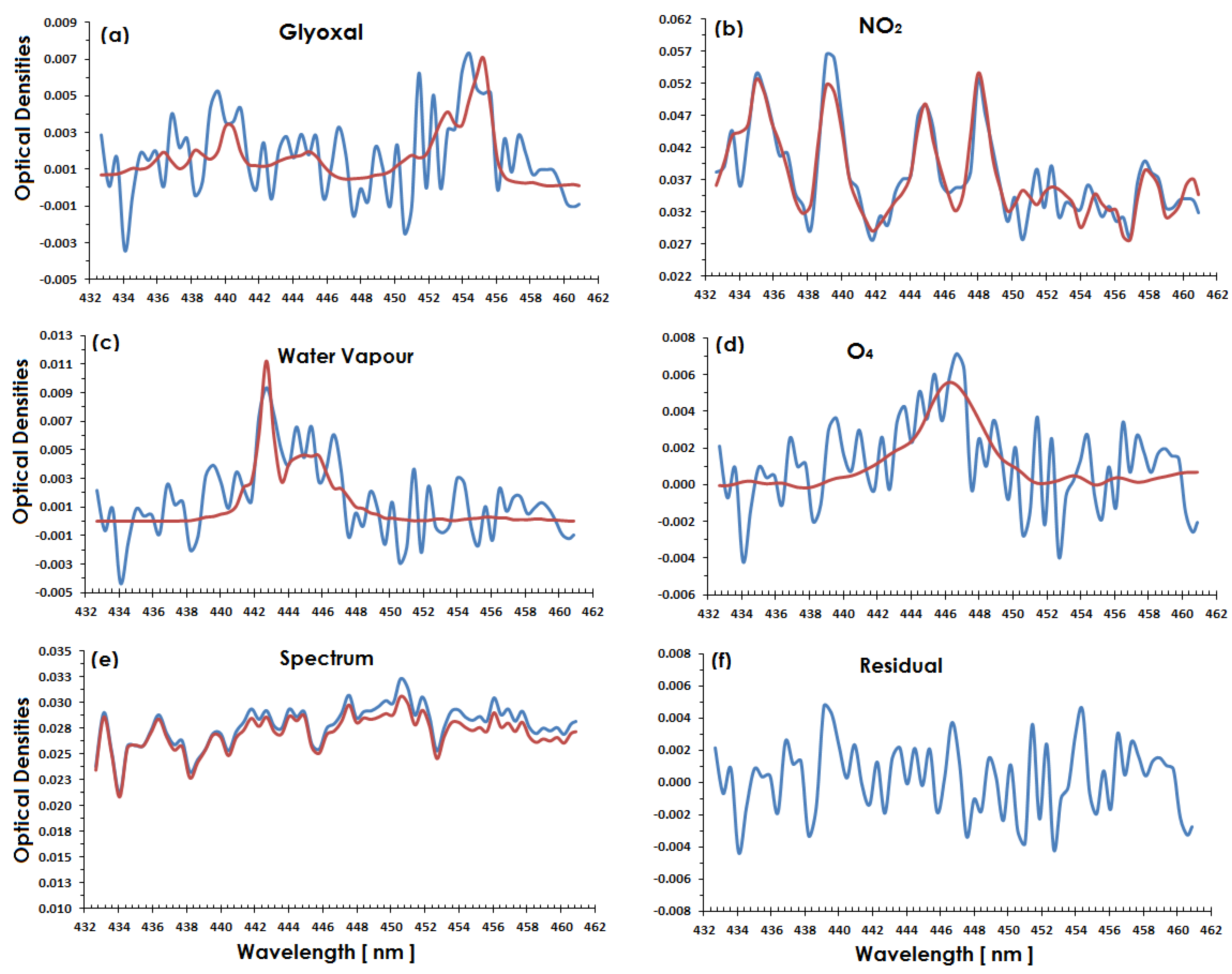


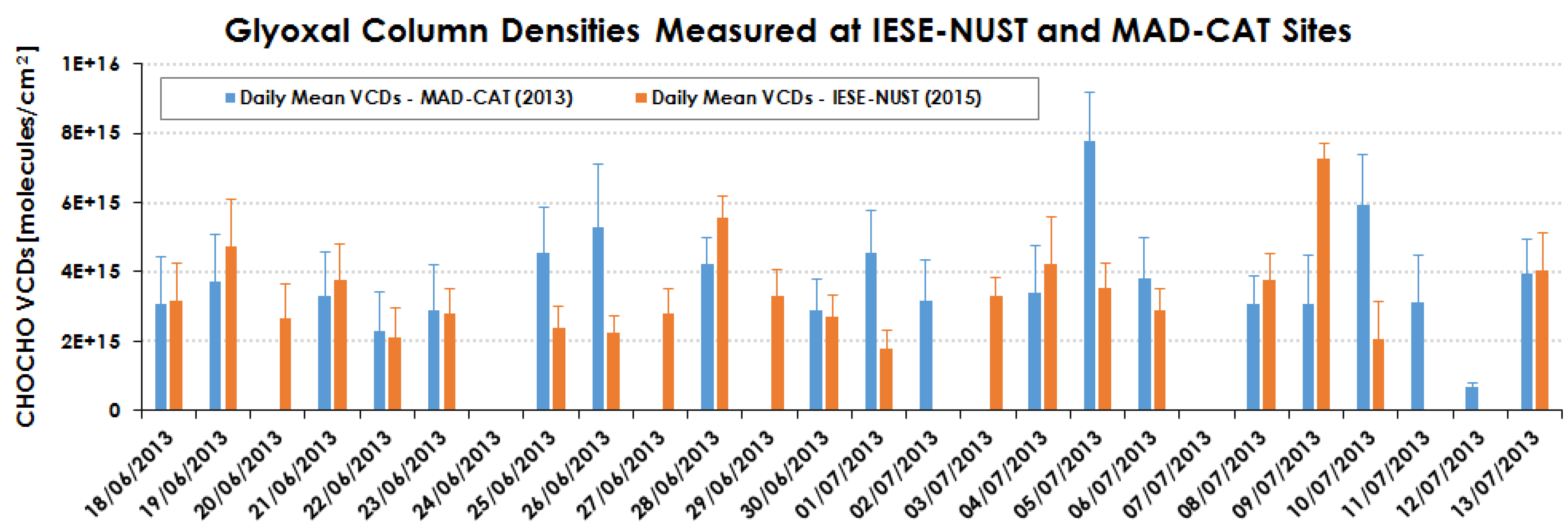
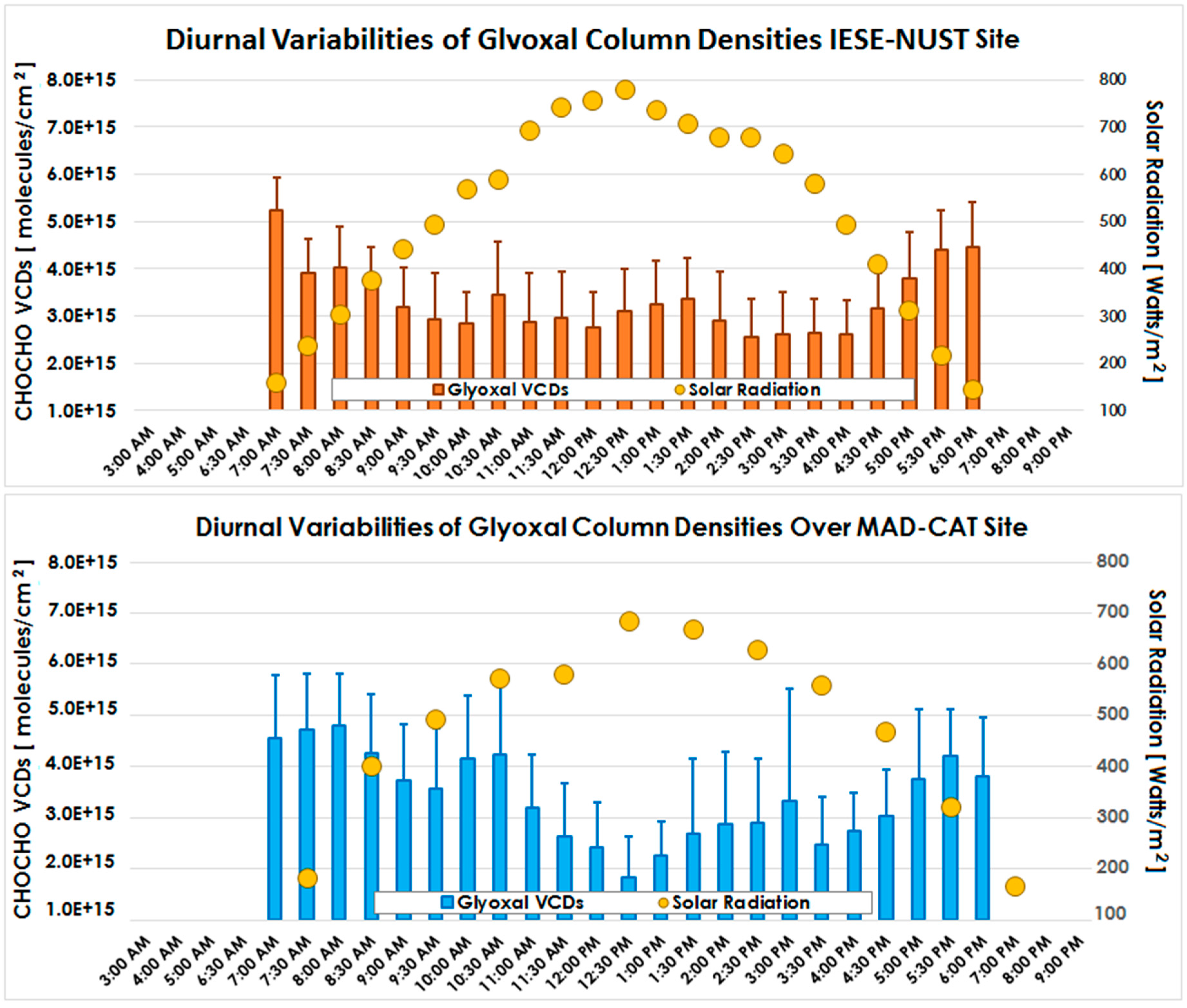
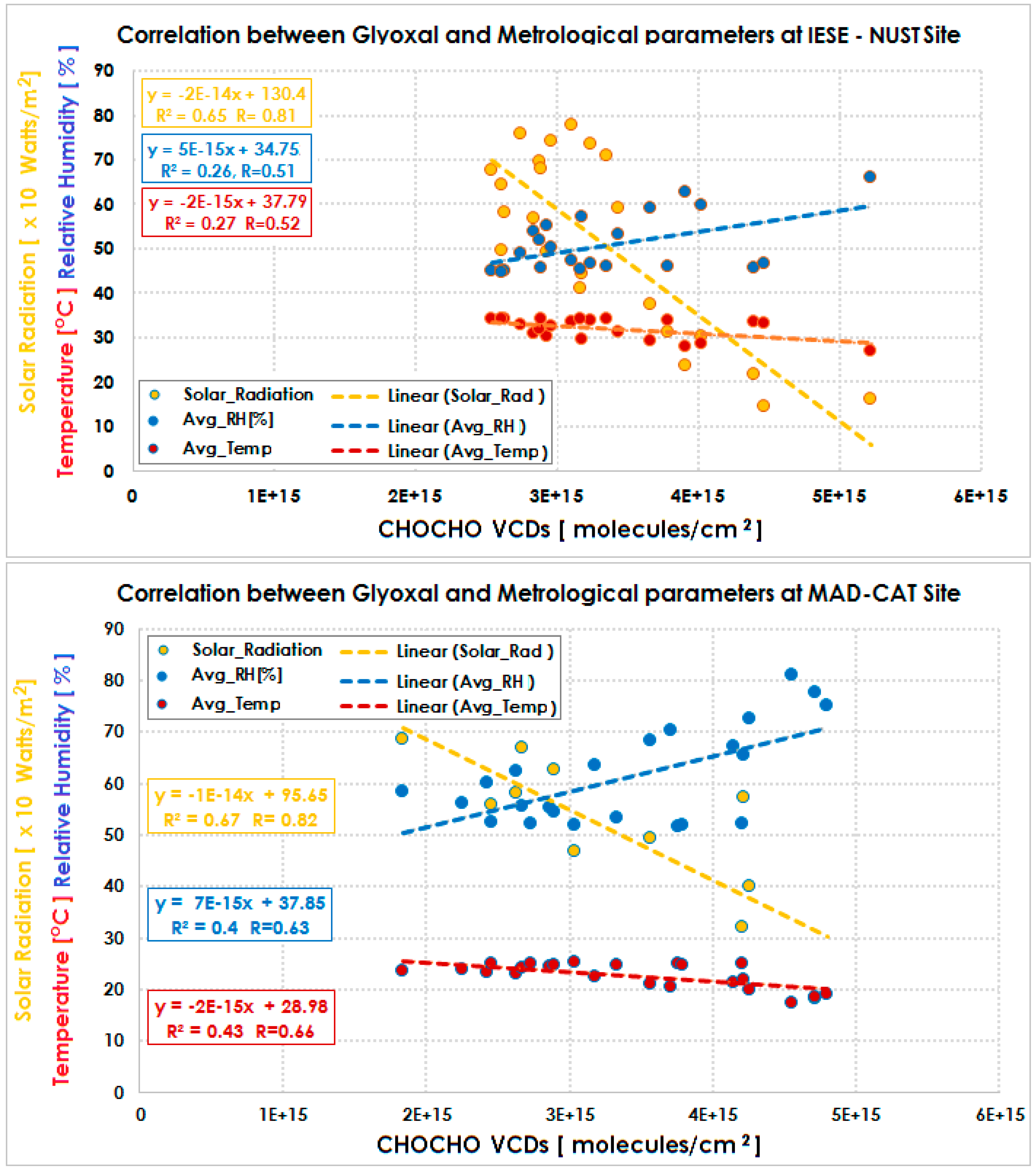
| S. No. | Study | DOAS Fit Settings | DOAS Fit Residual | ||
|---|---|---|---|---|---|
| Absorption Cross-Sections | References | Wavelength Range | |||
| 1 | This study | NO2 (220, 298 K) | Vandaele et al. [44] | 434–460 nm | 8 × 10−4 to 5 × 10−3 |
| O3 (223 K) | Bogumil et al. [45] | ||||
| O4 | Thalmanand and Volkamer, [46] | ||||
| CHOCHO | Volkamer et al. [47] | ||||
| H2O (296 K) | Rothman et al. [48] | ||||
| Ring | Ring_NDSC2003 [35] | ||||
| 2 | Li, et al., 2013 [18] | CHOCHO | Volkamer et al. [47] | 415–440 nm | 1 × 10−2 to 1 × 10−3 |
| H2O | Rothman et al. [49] | ||||
| NO2 | Voigt et al. [50] | ||||
| O3 (280 K) | Voigt et al. [51] | ||||
| O4 | Greenblatt et al. [52] | ||||
| 3 | Coburn, et al., 2011 [19] | O3 (223 K) | Bogumil et al. [45] | 434–460 nm | 6 × 10−5 to 1.4 × 10−4 |
| NO2 (294 K) | Vandaele et al. [44] | ||||
| O4 | Hermans [53] | ||||
| CHOCHO | Volkamer et al. [47] | ||||
| H2O | Rothman et al. [49] | ||||
| Ring | |||||
| 4 | Seinrich, et al., 2007 [17] | NO2 | Vandaele et al. [44] | 420–460 nm | 1.4 × 10−3 |
| O3 (223 K) | Bogumil et al. [45] | ||||
| O4 | Greenblatt et al. [52] | ||||
| CHOCHO | Volkamer et al. [47] | ||||
| H2O | Rothman et al. [49] | ||||
© 2016 by the authors; licensee MDPI, Basel, Switzerland. This article is an open access article distributed under the terms and conditions of the Creative Commons Attribution (CC-BY) license (http://creativecommons.org/licenses/by/4.0/).
Share and Cite
Khokhar, M.F.; Naveed, S.I.; Butt, J.K.; Abbas, Z. Comparative Analysis of Atmospheric Glyoxal Column Densities Retrieved from MAX-DOAS Observations in Pakistan and during MAD-CAT Field Campaign in Mainz, Germany. Atmosphere 2016, 7, 68. https://doi.org/10.3390/atmos7050068
Khokhar MF, Naveed SI, Butt JK, Abbas Z. Comparative Analysis of Atmospheric Glyoxal Column Densities Retrieved from MAX-DOAS Observations in Pakistan and during MAD-CAT Field Campaign in Mainz, Germany. Atmosphere. 2016; 7(5):68. https://doi.org/10.3390/atmos7050068
Chicago/Turabian StyleKhokhar, Muhammad Fahim, Syeda Ifraw Naveed, Junaid Khayyam Butt, and Zain Abbas. 2016. "Comparative Analysis of Atmospheric Glyoxal Column Densities Retrieved from MAX-DOAS Observations in Pakistan and during MAD-CAT Field Campaign in Mainz, Germany" Atmosphere 7, no. 5: 68. https://doi.org/10.3390/atmos7050068
APA StyleKhokhar, M. F., Naveed, S. I., Butt, J. K., & Abbas, Z. (2016). Comparative Analysis of Atmospheric Glyoxal Column Densities Retrieved from MAX-DOAS Observations in Pakistan and during MAD-CAT Field Campaign in Mainz, Germany. Atmosphere, 7(5), 68. https://doi.org/10.3390/atmos7050068







